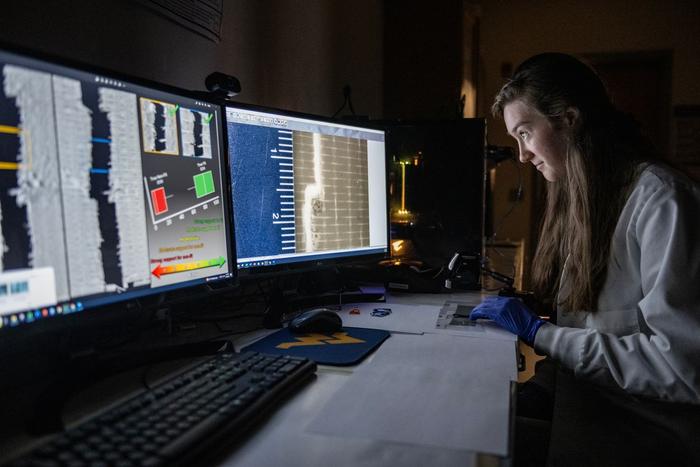Duct tape found at crime scenes can provide forensic scientists with important information, but no standardized protocol for analyzing it has ever existed.

Credit: WVU Photo/Brian Persinger
Duct tape found at crime scenes can provide forensic scientists with important information, but no standardized protocol for analyzing it has ever existed.
Now, Tatiana Trejos, assistant professor in the West Virginia University Department of Forensic and Investigative Science, and graduate student Meghan Prusinowski have developed a one-of-a-kind method that can help piece together a crime scene by literally piecing the evidence together. Or not.
The method provides a systematic approach for comparing pieces of trace evidence that appear to be from the same source. Prusinowski, a graduate research assistant, recently published the findings in Forensic Chemistry. Aldo Romero, Eberly Distinguished Professor of Physics and Astronomy, and statistician Cedric Neuman, Battelle Memorial Institute, contributed to the project.
Trace evidence is usually invisible to the naked eye but is likely to be transferred at a crime scene. This may come from contact between individuals or objects and may include things like fibers, glass or paint polymers.
“Duct tapes, in particular, are used very often to gag victims,” Trejos said. “So, when we have traces that are left, they can tell us about who was there, who tore it apart and so forth.
“In doing that, they need to separate the tape, and when they do that, they can leave fingerprints. They can leave DNA from the suspect, from the victim. But sometimes they are smart enough that they use gloves, so there are no fingerprints and there is no DNA.”
However, when a material like duct tape is separated into pieces, it leaves what forensic scientists call “fracture edges,” which can be evaluated and examined to see if there is a physical fit.
“A physical fit is putting the two fracture edges together and demonstrating that they have enough individual characteristics to indicate that they were once together,” Trejos said.
In forensic science, some types of evidence — DNA and fingerprints, for example — are extremely unlikely to have come from a source other than the one indicated. Physical fit has a similarly high level of association because of the random nature of the edge features left in the fracture edges.
“It is very unlikely that we can reproduce all the microscopic features of a torn edge,” Trejos said. “We can tear apart thousands and thousands of pieces, and we have demonstrated it’s very unlikely that there will be, just by random chance, a perfect fit in pieces that were not once together.”
Until now, there was little scientific basis to demonstrate that assumption. Trejos’ research will help the forensic community build a foundation to evaluate the error rates in this field. It considers the probability of having a random physical fit match, as well as performance rates and error rates and what factors might influence them.
Trejos said every forensic discipline has a group of experts that develop standards that can be used across the world.
“If I do a forensic examination here in West Virginia and I follow that protocol, the results should be the same if a colleague conducts the same examination in Australia,” she said. “For many other disciplines, we rely on our instruments. The analytical data is there and it’s very hard science. But in physical fit examination, the instrument is our brain. And our brain is fantastic at identifying those relevant, individual features, but we are also prone to subjectivity and bias if we don’t follow careful protocols.”
Trejos’ method allows examiners to qualify and quantify features and characteristics that are commonly observed during physical fit examinations. Then, the examiners follow the criteria to provide a score metric of how similar the tape edges are, estimate probabilities and use an Excel template to systematically document the features of the physical fit.
“I will write the report, but it’s not only my opinion, especially when we have something that depends on my judgment,” she said. “It will have to be separately and independently reviewed by a second examiner, who will follow the same protocol and have similar documentation templates. We can compare our opinions, and if we have disagreement, we can transparently discuss which was the criteria for that disagreement and defend those results in the courtroom.”
Using the method, Trejos and her students found the error rate was extremely low in duct tape physical fit examinations. The next step, she said, will be to teach forensic examiners how to follow the method.
“Historically, examiners have been very good at correctly identifying fits,” Prusinowski said. “But until recently, there hasn’t been much research identifying what can cause misidentifications, and there really haven’t been many studies that recommend a particular method for edge comparisons. So that’s what started the basis of my research.”
The team has led a series of interlaboratory studies to test the method using practitioners involved in physical fit examinations for years or even decades. Prusinowski also said the guidelines that help analyze physical fit will help researchers focus on pattern recognition in other trace evidence materials.
Trejos expects to see these methods adopted in forensic laboratories within a few years. The next step will be to provide other forensic labs with the scientific foundation the WVU team has established.
“They’ll have all the resources they need to present evidence in court,” Trejos said. “Because that can make the difference between sending an innocent person to jail or not.”
Journal
Forensic Chemistry
DOI
10.1016/j.forc.2023.100487
Article Title
Forensic interlaboratory evaluations of a systematic method for examining, documenting, and interpreting duct tape physical fits
Article Publication Date
5-Jul-2023




